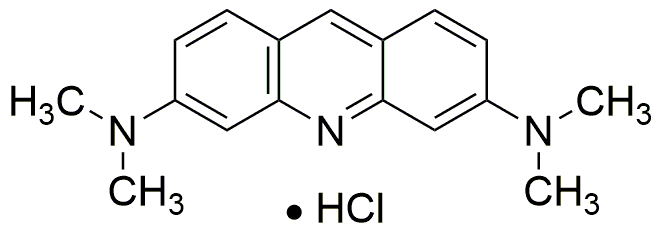Acridine orange hydrochloride solution, 10 mg/mL in H2O is widely utilized in research focused on:
- Cell Viability Assays: This compound is commonly used in laboratories to assess cell viability and cytotoxicity. By staining live and dead cells, researchers can easily differentiate between healthy and compromised cells, providing crucial data for drug development and toxicity studies.
- Fluorescence Microscopy: Its fluorescent properties make it an excellent choice for visualizing cellular structures and processes under a fluorescence microscope. This is particularly beneficial in fields like cell biology and microbiology, where understanding cellular dynamics is essential.
- DNA and RNA Staining: Acridine orange is effective for staining nucleic acids, allowing researchers to study genetic material in various organisms. This application is vital in genetics and molecular biology, enhancing the understanding of gene expression and cellular function.
- Histological Studies: In histology, this compound aids in the examination of tissue samples. Its ability to highlight specific cellular components helps pathologists and researchers identify abnormalities, contributing to disease diagnosis and research.
- Antimicrobial Research: The compound is also explored for its potential in antimicrobial studies. By evaluating its effects on microbial cells, researchers can investigate new therapeutic agents, which is crucial in combating antibiotic resistance.
General Information
Properties
Safety and Regulations
Applications
Acridine orange hydrochloride solution, 10 mg/mL in H2O is widely utilized in research focused on:
- Cell Viability Assays: This compound is commonly used in laboratories to assess cell viability and cytotoxicity. By staining live and dead cells, researchers can easily differentiate between healthy and compromised cells, providing crucial data for drug development and toxicity studies.
- Fluorescence Microscopy: Its fluorescent properties make it an excellent choice for visualizing cellular structures and processes under a fluorescence microscope. This is particularly beneficial in fields like cell biology and microbiology, where understanding cellular dynamics is essential.
- DNA and RNA Staining: Acridine orange is effective for staining nucleic acids, allowing researchers to study genetic material in various organisms. This application is vital in genetics and molecular biology, enhancing the understanding of gene expression and cellular function.
- Histological Studies: In histology, this compound aids in the examination of tissue samples. Its ability to highlight specific cellular components helps pathologists and researchers identify abnormalities, contributing to disease diagnosis and research.
- Antimicrobial Research: The compound is also explored for its potential in antimicrobial studies. By evaluating its effects on microbial cells, researchers can investigate new therapeutic agents, which is crucial in combating antibiotic resistance.
Documents
Safety Data Sheets (SDS)
The SDS provides comprehensive safety information on handling, storage, and disposal of the product.
Product Specification (PS)
The PS provides a comprehensive breakdown of the product’s properties, including chemical composition, physical state, purity, and storage requirements. It also details acceptable quality ranges and the product's intended applications.
Certificates of Analysis (COA)
Search for Certificates of Analysis (COA) by entering the products Lot Number. Lot and Batch Numbers can be found on a product’s label following the words ‘Lot’ or ‘Batch’.
Numéro de catalogue
Numéro de lot/série
Certificates Of Origin (COO)
This COO confirms the country where the product was manufactured, and also details the materials and components used in it and whether it is derived from natural, synthetic, or other specific sources. This certificate may be required for customs, trade, and regulatory compliance.
Numéro de catalogue
Numéro de lot/série
Safety Data Sheets (SDS)
The SDS provides comprehensive safety information on handling, storage, and disposal of the product.
DownloadProduct Specification (PS)
The PS provides a comprehensive breakdown of the product’s properties, including chemical composition, physical state, purity, and storage requirements. It also details acceptable quality ranges and the product's intended applications.
DownloadCertificates of Analysis (COA)
Search for Certificates of Analysis (COA) by entering the products Lot Number. Lot and Batch Numbers can be found on a product’s label following the words ‘Lot’ or ‘Batch’.
Numéro de catalogue
Numéro de lot/série
Certificates Of Origin (COO)
This COO confirms the country where the product was manufactured, and also details the materials and components used in it and whether it is derived from natural, synthetic, or other specific sources. This certificate may be required for customs, trade, and regulatory compliance.

